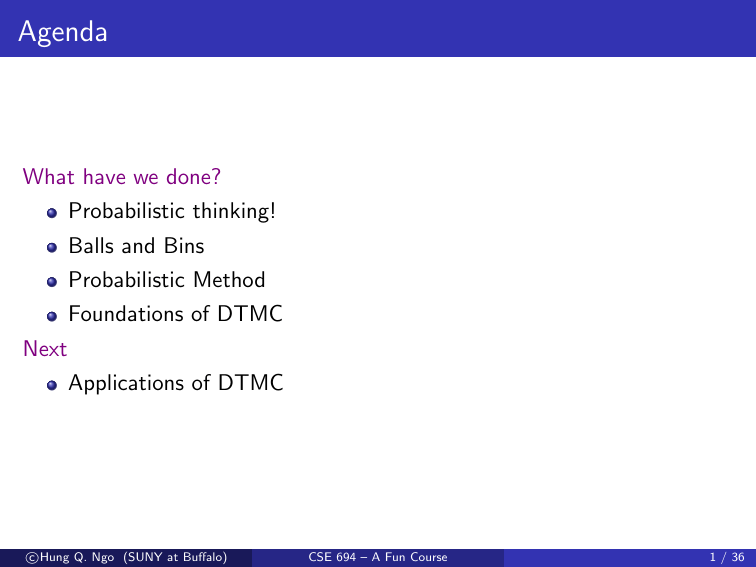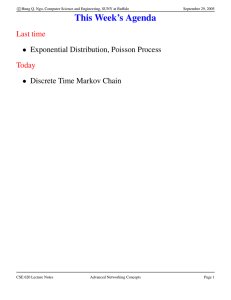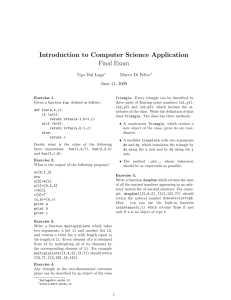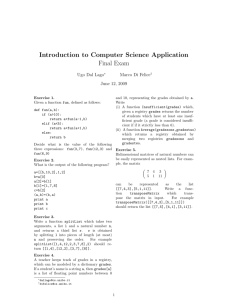Document 10754557

Agenda
What have we done?
Probabilistic thinking!
Balls and Bins
Probabilistic Method
Foundations of DTMC
Next
Applications of DTMC c Hung Q. Ngo (SUNY at Buffalo)
1 / 36
Example 1: a Randomized 2 -SAT Algorithm
2 -SAT Problem : given a 2 -CNF formula ϕ , find a satisfying truth assignment
A Randomized Algorithm for 2 -SAT
1 Repeat the following at most m times
2
3
4
5
Pick a truth assignment t at random
If t ( ϕ ) = true
, then choose a non-satisfying clause, flip a literal
Else ( t ( ϕ ) = true
), return t
Return not satisfiable after m steps c Hung Q. Ngo (SUNY at Buffalo)
3 / 36
Analysis of the Algorithm
If there’s no satisfying truth assignment, we’re OK.
Suppose there’s one truth assignment ¯
At step i , let Y i be the Hamming distance from t to
Then, we want Y i
= 0 for some i . We know
Prob [ Y i +1
= k − 1 | Y i
= k ] ≥ 1 / 2
Prob [ Y i +1
= k + 1 | Y i
= k ] ≤ 1 / 2
{ Y i
} i ≥ 0 is generally not a Markov chain
Define a Markov chain { X i
} i ≥ 0
, state space I = { 0 , 1 , · · · , n }
Prob [ X i +1
= k − 1 | X i
= k ] = 1 / 2
Prob [ X i +1
= k + 1 | X i
= k ] = 1 / 2 c Hung Q. Ngo (SUNY at Buffalo)
4 / 36
Analysis of the Algorithm
{ Y i
} i ≥ 0
“leans left” heavier than { X i
} i ≥ 0
Expected number of steps until some Y i
= 0 is at most expected number of steps until some X i
= 0
Key: we do know how to compute the expected number of steps until
{ X i
} i ≥ 0
“hits” { 0 } .
The mean hitting times to the following
µ i
= µ
{ 0 } i are minimal non-negative solutions
µ
0
= 0
1
µ i
= 1 + ( µ
2
µ n
= 1 + µ n − 1 i − 1
+ µ i +1
) , 1 ≤ i ≤ n − 1
Induction gives µ n − i
= n
2 − i
2 c Hung Q. Ngo (SUNY at Buffalo)
5 / 36
Analysis of the Algorithm
Let X be the number of steps until 0 is reached
Conditioning on the initial state, E [ X ] ≤ n
2
By Markov
Prob [ X ≥ m ] ≤ n
2 m
=
1
2 for m = 2 n
2
Run independently k times, error probability is reduced to
2
1 k c Hung Q. Ngo (SUNY at Buffalo)
6 / 36
Example 2: Undirected s, t -Connectivity ( unstconn
) unstconn
Given a graph G , two vertices s and t . Is there an s, t -path?
The Low-Space Solution
Start from s , keep walking on the graph randomly for some time. If t is found: return yes
, otherwise return no
.
Main question
How many steps must be taken so that the false negative probability is at most ?
Need some basic results on random walks on graphs c Hung Q. Ngo (SUNY at Buffalo)
7 / 36
Random Walks on Graphs – Basic Observations
Definition
G = ( V, E ) a finite and connected undirected graph. A random walk on G is a Markov chain on V where p uv
= 1 / deg( u )
Basic observations
The walk is irreducible and recurrent, has an invariant distribution
π v
= deg( v )
, m = | E | .
2 m
Thus, it is positive recurrent
The walk is aperiodic iff G is not bipartite, in which case π is the limit distribution
We will assume G is non-bipartite henceforth c Hung Q. Ngo (SUNY at Buffalo)
8 / 36
Random Walks on Graphs – Basic Parameters
µ u,v
: hitting time (or mean hitting time ) is the expected number of steps to hit v starting from u
κ ( u, v ) = µ u,v
+ µ v,u
: commute time
Cover time C ( G ) is the expected number of steps until all nodes are visited. If no starting node is specified, we mean the worst case, i.e.
starting from the node with worst cover time.
Mixing rate measures how fast the walk converges (defined precisely later)
Question
Determine the hitting times and cover time for a random walk on K n c Hung Q. Ngo (SUNY at Buffalo)
9 / 36
Random Walks on Graphs – Basic Results
Lemma
µ v,v
=
π
1 v
=
2 m deg( v )
Lemma
For any edge uv ∈ E ( G ) , κ ( u, v ) ≤ 2 m
Theorem (Cover time bound)
C ( G ) ≤ 2 m ( n − 1) c Hung Q. Ngo (SUNY at Buffalo)
10 / 36
Back to the unstconn
Problem
If there’s no s, t -path, the algorithm returns no correctly
If there’s a path, the walk hits t in expected time at most
C ( G ) ≤ 2 mn < 2 n
3
Applying Markov as usual, a walk of length 4 n
3 false positive probability ≤ 1 / 2 is sufficient to make
Important to note: the algorithm uses only O (log n ) -space, so unstconn
∈ RL (randomized log-space)
In 2004, Omer Reingold showed a beautiful result that the problem can be solved deterministically in log-space, implying L = SL
His result makes use of expanders which we’ll discuss next c Hung Q. Ngo (SUNY at Buffalo)
11 / 36
Another Proof of Convergence to Equilibrium
Let us first assume G is d -regular, A is the adjacency matrix
Transition probability matrix for the random walk is the normalized adjacency matrix
ˆ
=
1 d
A
Both
ˆ and A are real and symmetric
λ is an eigenvalue of same eigenvector
A iff
ˆ
= λ/d is an eigenvalue of
ˆ with the
The set of eigenvalues of A is called the spectrum of the graph G c Hung Q. Ngo (SUNY at Buffalo)
13 / 36
Spectral Theorem for Real and Symmetric Matrices
Theorem (Spectral Theorem for Real and Symmetric Matrices)
Let A be any real and symmetric n × n matrix, then there is an orthogonal matrix Q (columns are orthogonal) such that
A = QΛQ
− 1 where Λ is a real diagonal matrix with entries ( λ
1
, . . . , λ n
) .
In particular, the columns q
1
, · · · , q n of Q are orthogonal eigenvectors of
A with corresponding eigenvalues λ
1
, . . . , λ n c Hung Q. Ngo (SUNY at Buffalo)
14 / 36
Properties of Spectrum of a Graph
Let λ
1
≥ · · · ≥ λ n be the spectrum of a d -regular graph G , then
1 is a d -eigenvector, i.e.
A1 = d 1
λ
1
= d
| λ i
| ≤ d for all i
G is connected if and only if λ i
< d for all i ≥ 2
G is not bipartite if and only if λ n
= − d
Thus, if G is connected and not bipartite, its spectrum is d = λ
1
> λ
2
≥ · · · ≥ λ n
> − d
In particular,
λ ( G ) = max {| λ
2
| , | λ n
|} < λ
1
= d c Hung Q. Ngo (SUNY at Buffalo)
15 / 36
Another Proof of Convergence for Random Walks on G
The uniform distribution u = 1 /n is a 1 -eigenvector of
ˆ
, thus the uniform distribution is an invariant distribution of the random walk.
ˆ
( G ) = max {|
ˆ
2
| , |
ˆ n
|} <
ˆ
1
= 1
Let u
2
, . . . , u n be the other orthogonal eigenvectors of any initial distribution π ,
ˆ
, then for
π = c
1 u + c
2 u
2
+ · · · c n u n
Since π is a distribution, h π, u i = 1 /n , implying c
1
= 1 . Thus,
π = u + c
2 u
2
+ · · · c n u n
Consequently, we obtain another proof of the convergence theorem:
A k
π = u + c
2
λ k
2 u
2
+ · · · c n
λ k n u n c Hung Q. Ngo (SUNY at Buffalo)
16 / 36
Summary: Large Spectral Gap ⇒ Fast Convergence
G : finite, connected and non-bipartite
Then, |
ˆ i
| ≤
ˆ
( G ) < 1 , ∀ i ≥ 2 .
Moreover, we proved
A k
π = u + c
2
λ k
2 u
2
+ · · · c n
λ k n u n which implies lim k →∞
A k
π = u , for any initial distribution π of the random walk.
1 −
ˆ
( G ) is called the spectral gap (equivalently, d − λ ( G ) )
Large spectral gap ⇒ fast convergence c Hung Q. Ngo (SUNY at Buffalo)
17 / 36
How to Measure Convergence Speed?
Want to know how far π
( k )
A k
π is from u
Could try l
1
, l
2
, l
∞ norms, but what do they mean probabilistically?
Definition (Total Variation Distance)
Given two distributions P and Q on a countable sample space Ω , the total variation distance between P and Q is the largest possible difference in probabilities that the two distributions can assign to the same event.
Namely, k P − Q k = sup
A ⊂ Ω
| P ( A ) − Q ( A ) | , where P ( A ) = P
ω ∈ A
P ( ω ) , Q ( A ) = P
ω ∈ A
Q ( ω ) .
c Hung Q. Ngo (SUNY at Buffalo)
18 / 36
Variation Distance on Countable State Space
Lemma
When Ω is countable, k P − Q k =
1
X
| P ( ω ) − Q ( ω ) |
2
ω ∈ Ω
In other words, the distance is half the l
1
-norm of the vector P − Q .
c Hung Q. Ngo (SUNY at Buffalo)
19 / 36
Convergence Speed (Mixing Rate) of Random Walks
Theorem
Let G be finite, connected, non-bipartite, and d -regular with
Then, for any initial distribution π we have
ˆ
( G ) < 1 .
k
ˆ k
π − u k
1
≤
√ n λ k
.
Proof.
k ˆ
π − u k
2
= k ˆ
( π − u ) k
2
≤ ˆ k π − u k
2
≤ ˆ
Inductively, k ˆ k
π − u k
2
≤ ˆ k k π − u k
2
≤ ˆ k
Cauchy-Schwartz completes the proof.
(Note: there’s also a notion of convergence in entropy.) c Hung Q. Ngo (SUNY at Buffalo)
20 / 36
Mixing Lemma
Lemma (Expander Mixing Lemma)
Let G = ( V, E ) be a d -regular graph on n vertices, λ = λ ( G ) ,
ˆ
Let ( S, T ) = { ( u, v ) | u ∈ S, v ∈ T } (set of ordered pairs). Then,
λ ( G ) .
∀ S, T ⊆ V , d | S || T |
| ( S, T ) | − ≤ λ p
| S || T | n
Simple Consequences, when
ˆ
1
Maximum independent set size of G is at most
Chromatic number is at least 1 /
ˆ
Diameter is O (log n ) c Hung Q. Ngo (SUNY at Buffalo)
21 / 36
Spectral Expansion and Edge Expansion
Edge boundary ∂ ( S ) of S ⊂ V :
∂ ( S ) = | ( S,
¯
) |
Edge expansion ratio h ( G ) of G : h ( G ) = min
S ⊂ V, | S |≤ n/ 2
| ∂S |
| S | also called Cheeger constant or Cheeger number of G
Theorem (Connection between edge expansion and spectral gap)
Let G be d -regular with spectrum λ
1
≥ · · · ≥ λ n
. Then, d − λ
2
2
≤ h ( G ) ≤ p
2 d ( d − λ
2
) c Hung Q. Ngo (SUNY at Buffalo)
22 / 36
Expanders: Finally!
Three definitions which are more or less equivalent. (We only consider regular expanders for simplicity.)
Definition (Spectral Expander)
A d -regular graph G is called an α -spectral expander if
ˆ
( G ) ≤ α .
Definition (Edge Expander)
A d -regular graph G is called an β -edge expander if h ( G ) ≥ β .
Definition (Vertex Expander)
A d -regular graph G is called an γ -vertex expander if min
S ⊂ V, | S |≤ n/ 2
| Γ( S ) |
| S |
≥ γ.
c Hung Q. Ngo (SUNY at Buffalo)
23 / 36
They are More or Less Equivalent
We have seen a relationship between spectral expansion and edge expansion before. We connect spectral vs. vertex expansion below.
Lemma
An α -spectral expander is also a
α
2
2
+1
-vertex expander
Lemma
A β -vertex expander is also an α -spectral expander with
α = s
( β − 1) 2
1 − d 2 (8 + 4( β − 1) 2 )
It is straightforward to connect vertex vs. edge expansions.
c Hung Q. Ngo (SUNY at Buffalo)
24 / 36
Family of Expanders
Definition
A sequence of d -regular graphs { G i there exists > 0 such that
ˆ
( G i
)
}
≤
∞ i =1
1 − is a family of spectral expanders for all i .
if n i
= | V ( G i
) | are required to be strictly increasing.
(Families of vertex- and edge-expanders are defined similarly.)
Intuitively, good families of expanders (i.e. usable for most applications) satisfy the following
{ n i
} is not increasing too fast (e.g., n i +1
≤ n
2 i the G i can be generated in polynomial time is good) c Hung Q. Ngo (SUNY at Buffalo)
25 / 36
Good Families of Expanders
Let { G i
} be a family of d -regular expanders, where { n i
} is increasing but not too fast the family is called mildly explicit if there’s an algorithm generating the i th graph G i in time polynomial in i the family is called very explicit if there’s an algorithm which, on inputs i and v ∈ [ n i
] and k ∈ [ d ] , computes the k th neighbor of v in
G i in time polynomial in (the binary representation of) the input
( i, v, k ) c Hung Q. Ngo (SUNY at Buffalo)
26 / 36
Example: Margulis Construction
Margulis (1973) constructed the following expander family
For every integer m ,
V ( G m
) =
Z m
×
Z m neighbors of ( x, y ) are ( x + y, y ) , ( x − y, y ) , ( x, y + x ) , ( x, y − x ) , ( x + y + 1 , y ) , ( x − y + 1 , y ) , ( x, y + x + 1) , ( x, y − x + 1) (all operations done in the ring
Z m
) this is a family of very explicit 8 -regular expanders c Hung Q. Ngo (SUNY at Buffalo)
27 / 36
Applications of Expanders and Random Walks on
Expanders
Numerous
Constructing good topologies for P2P networks
Taking double cover of expanders gives bipartite expanders
(remember magical graph from the first weak): can be used to construct good error-correcting codes, superconcentrators, concentrators, good interconnection networks, etc.
Construct parallel sorting networks of size O ( n lg n ) (a huge result!)
Efficient error reduction in probabilistic algorithms
Metric embedding
PCP Theorem and many other results in complexity theory
(remember Reingold’s result)
...
(See Bulletin of the AMS Survey by Hoory, Linial, and Wigderson) c Hung Q. Ngo (SUNY at Buffalo)
28 / 36
Application: Efficient Error Reduction
Some problems whose most efficient solutions are randomized algorithms:
Primality testing : is the input a prime?
Polynomial identity checking: is P ( x ) Q ( x ) ≡ R ( x ) for given polynomials P, Q, R under some finite field
Matrix indentity checking: is AB = C for matrices on finite fields
These are examples of decision problems Π which have a randomized poly-time (Monte Carlo) algorithm A satisfying the following:
On input x of size n , A uses r = r ( n ) random bits x ∈ Π yes x ∈ Π no
= ⇒ Prob s ∈{ 0 , 1 } r
[ A ( x, s ) = yes
] ≥ 1 / 2
= ⇒ Prob s ∈{ 0 , 1 } r
[ A ( x, s ) = no
] = 1
RP is the complexity class consisting of these kinds of problems c Hung Q. Ngo (SUNY at Buffalo)
29 / 36
The Straightforward Way to Reduce Error Probability
Pick k random strings s
1
, . . . , s k
∈ { 0 , 1 } r
Return no only if all A ( x, s i
) say no
False negative probability is (1 / 2) k
Number of random bits used is kr
Another view of this method
For any input x , let B x be the set of strings s ∈ { 0 , 1 } r which A ( x, s ) gives the wrong answer for x
= Ω for
If x ∈ Π yes
, | B x
| ≤ | Ω | / 2
The algorithm sample k independent points from Ω
Probability that all k points are bad (i.e. in B x
) is at most (1 / 2) k c Hung Q. Ngo (SUNY at Buffalo)
30 / 36
Sampling by Random Walk on Expanders
Let G = ( V, E ) be a very explicit d -regular α -spectral expander where
V = Ω , where α < 1 / 2
Instead of sampling k independent points, start from a uniformly random vertex s
0 of G and take a random walk of length k : s
0
, s
1
, . . . , s k
Run A ( x, s i
) and return no only if all A ( x, s i
) says no
Number of random bits used is r + k log
2 d = r + O ( k )
Error probability equal the probability that all s
0
, . . . , s k stay inside B x
Let G = ( V, E ) be an α -spectral expander. Consider B ⊂ V , | B | ≤ β | V | .
The probability that a random walk of length k (with uniformly chosen initial vertex) stays inside B the entire time is at most ( α + β ) k
.
c Hung Q. Ngo (SUNY at Buffalo)
31 / 36
Proof of AKS Theorem
Let P be the orthogonal projection onto the coordinates B , i.e.
P = ( p ij
) where p ij
= 1 iff i = j ∈ B , p ij
= 0 otherwise.
The probability that the lengthk walk stays in B is k ( P
ˆ
) k
P u ) k
1
(conditioned on s
0
∈ B , apply Chapman-Kolmogorov equation)
Next, for any vector v , k P
ˆ
P v ) k
2
≤ ( α + β ) k v k
2
Finally, k ( P
ˆ
) k
P u ) k
1
≤
=
≤
√ n k ( P
√ n k ( P
ˆ
) k
P
ˆ
P ) k
√ n ( α + β ) k k u u u
)
) k k k
2
2
2
= ( α + β ) k c Hung Q. Ngo (SUNY at Buffalo)
32 / 36
How Big can the Spectral Gap be?
The best expander is K n
, whose spectrum is
[ n − 1 , − 1 , − 1 , . . . , − 1]
However, we are interested in cases where n d . In this case,
Theorem (Alon-Boppana)
If G is d -regular with n vertices, then,
λ ( G ) ≥ 2
√ d − 1 − o n
(1)
A d -regular graph G is called a Ramanujan Graph if λ ( G ) ≤ 2
√ d − 1
Amazingly : Ramanujan graphs can be constructed explicitly when d − 1 is any prime power. (Using Cayley graphs of projective linear groups.) c Hung Q. Ngo (SUNY at Buffalo)
33 / 36
Many Other Known Constructions
Most random graphs are expanders
Most random graphs are Ramanujan graphs!!!
Many explicit constructions based on Cayley graphs
Zig-Zag Product! (Lead to Reingold’s result) c Hung Q. Ngo (SUNY at Buffalo)
34 / 36
TBD c Hung Q. Ngo (SUNY at Buffalo)
36 / 36


